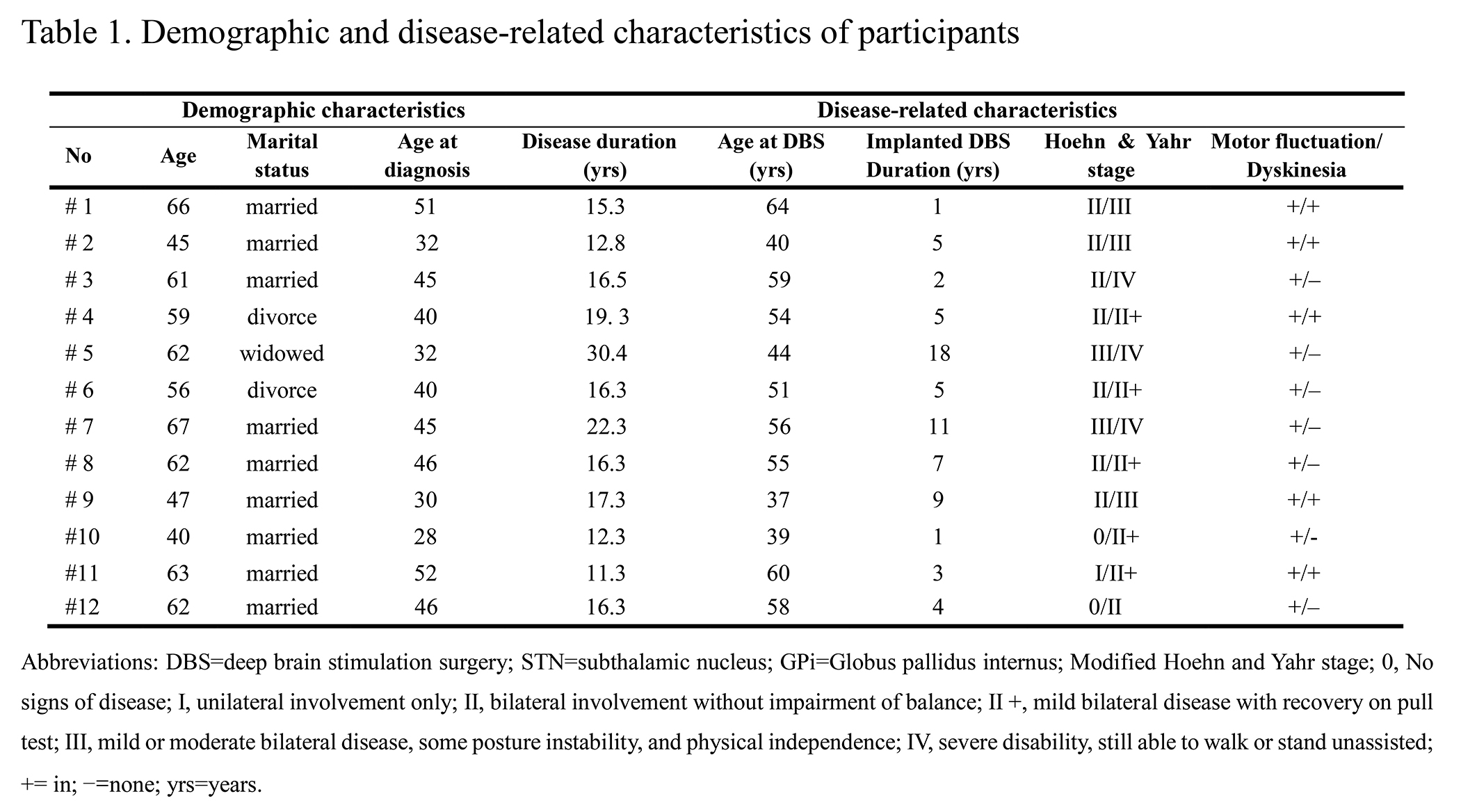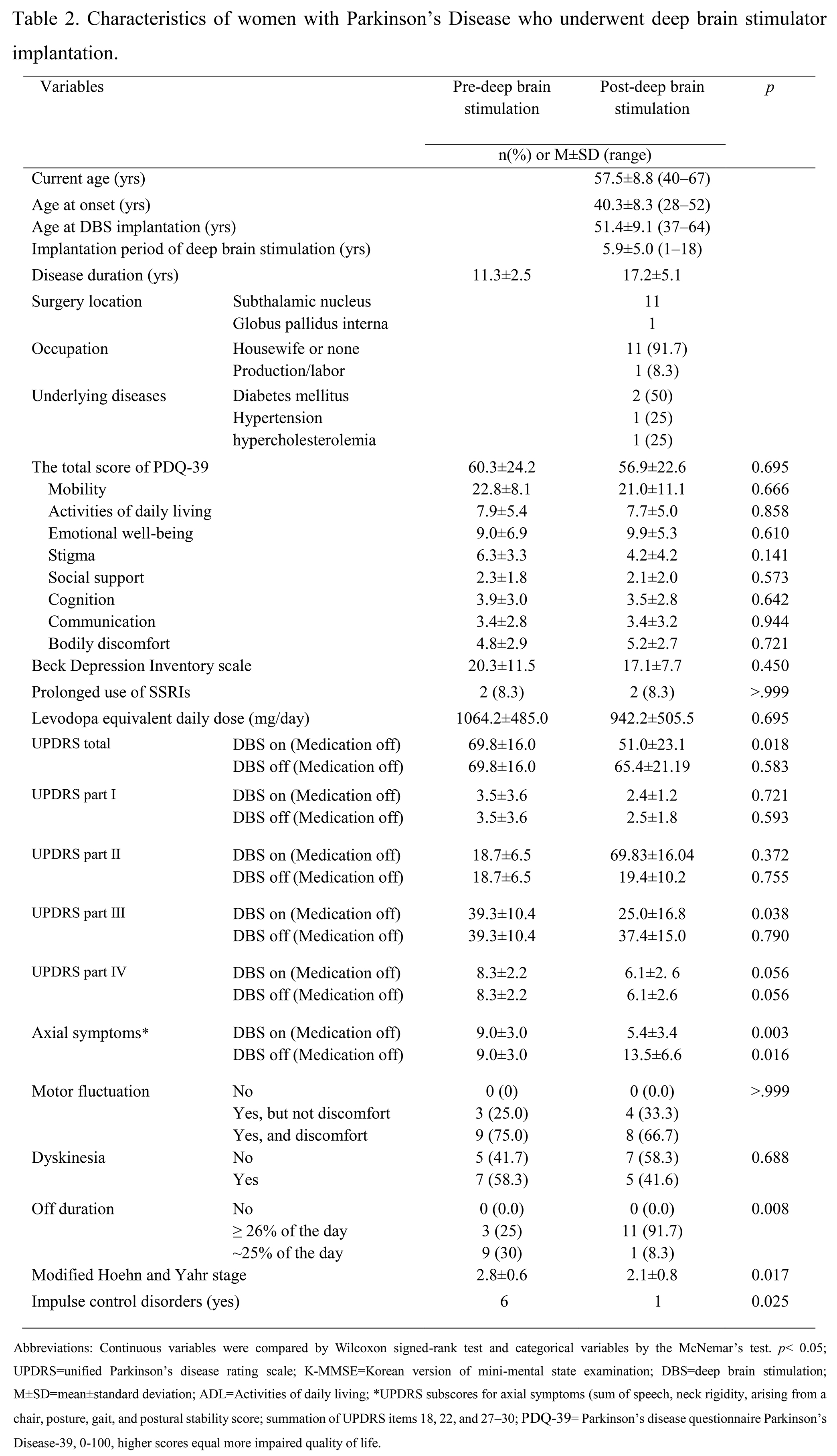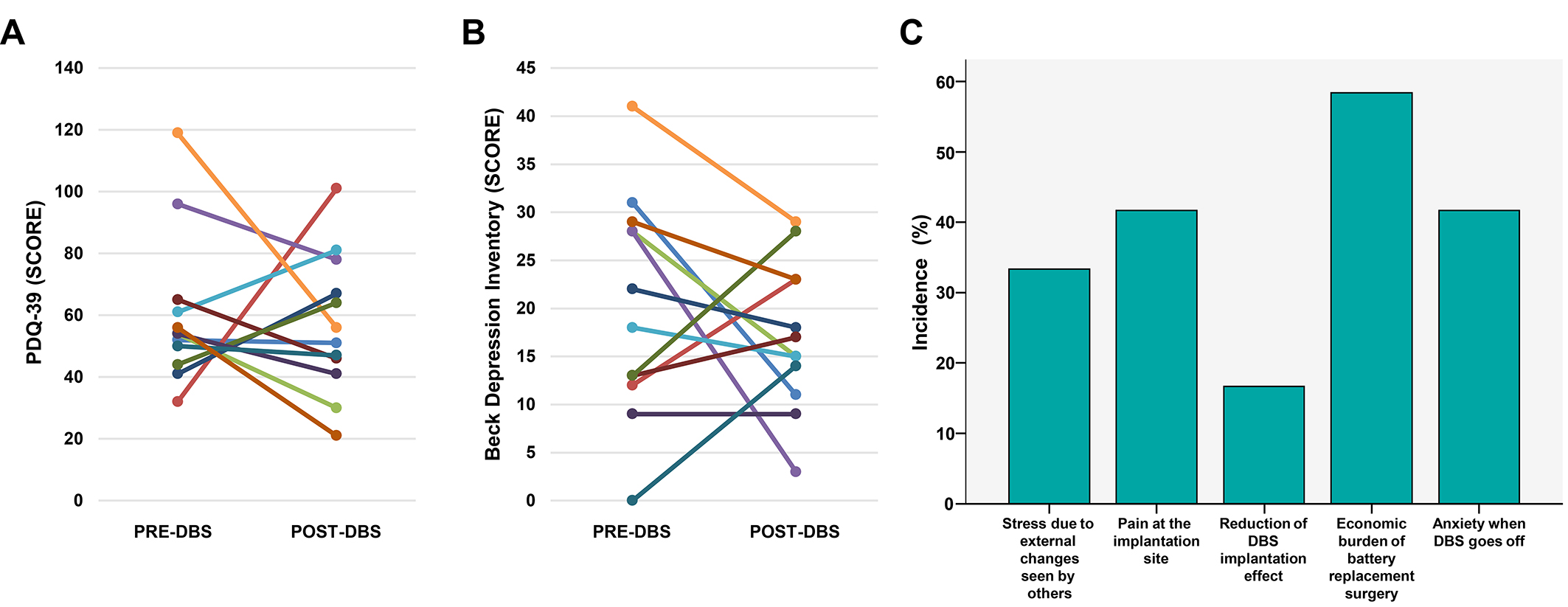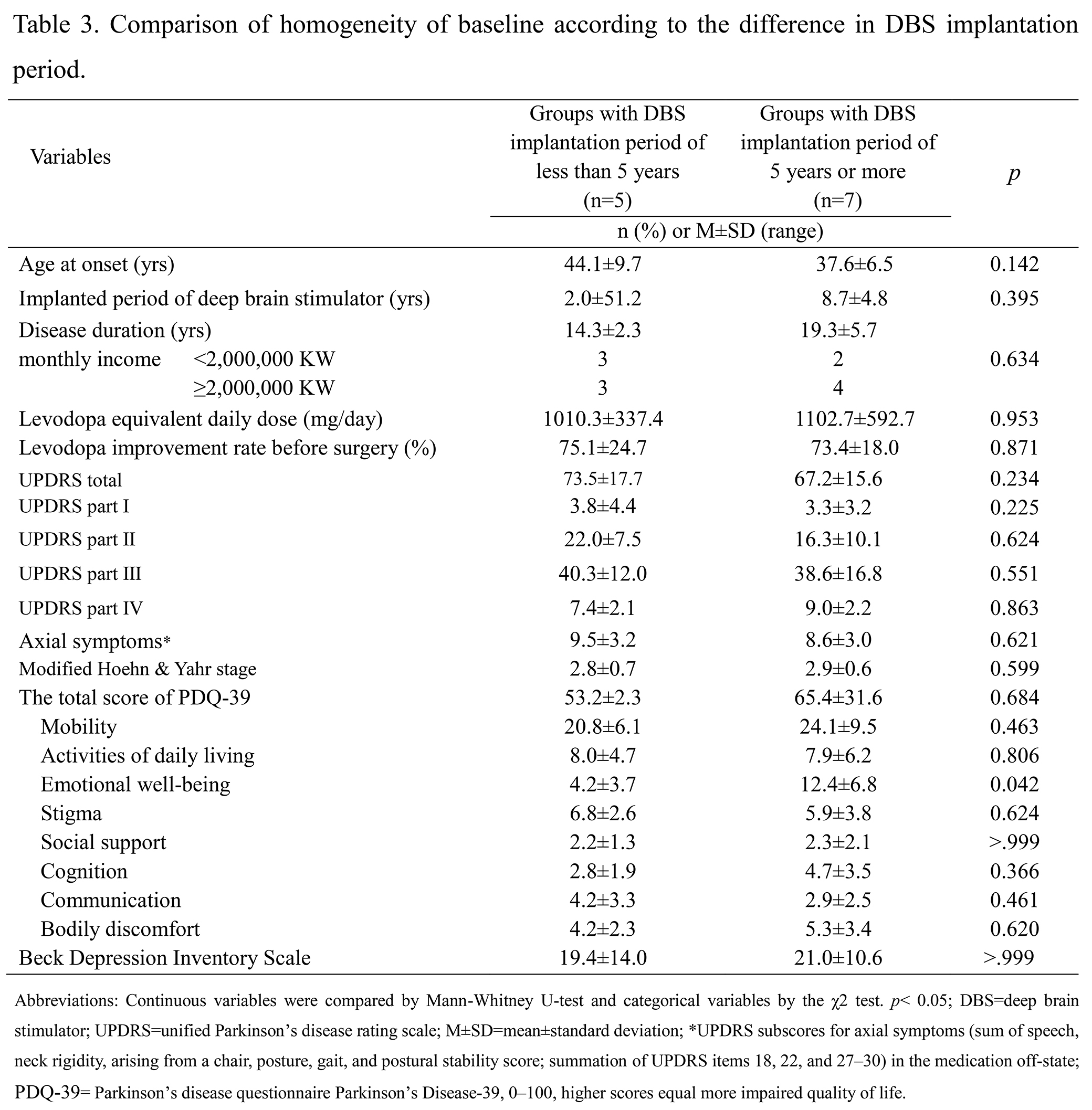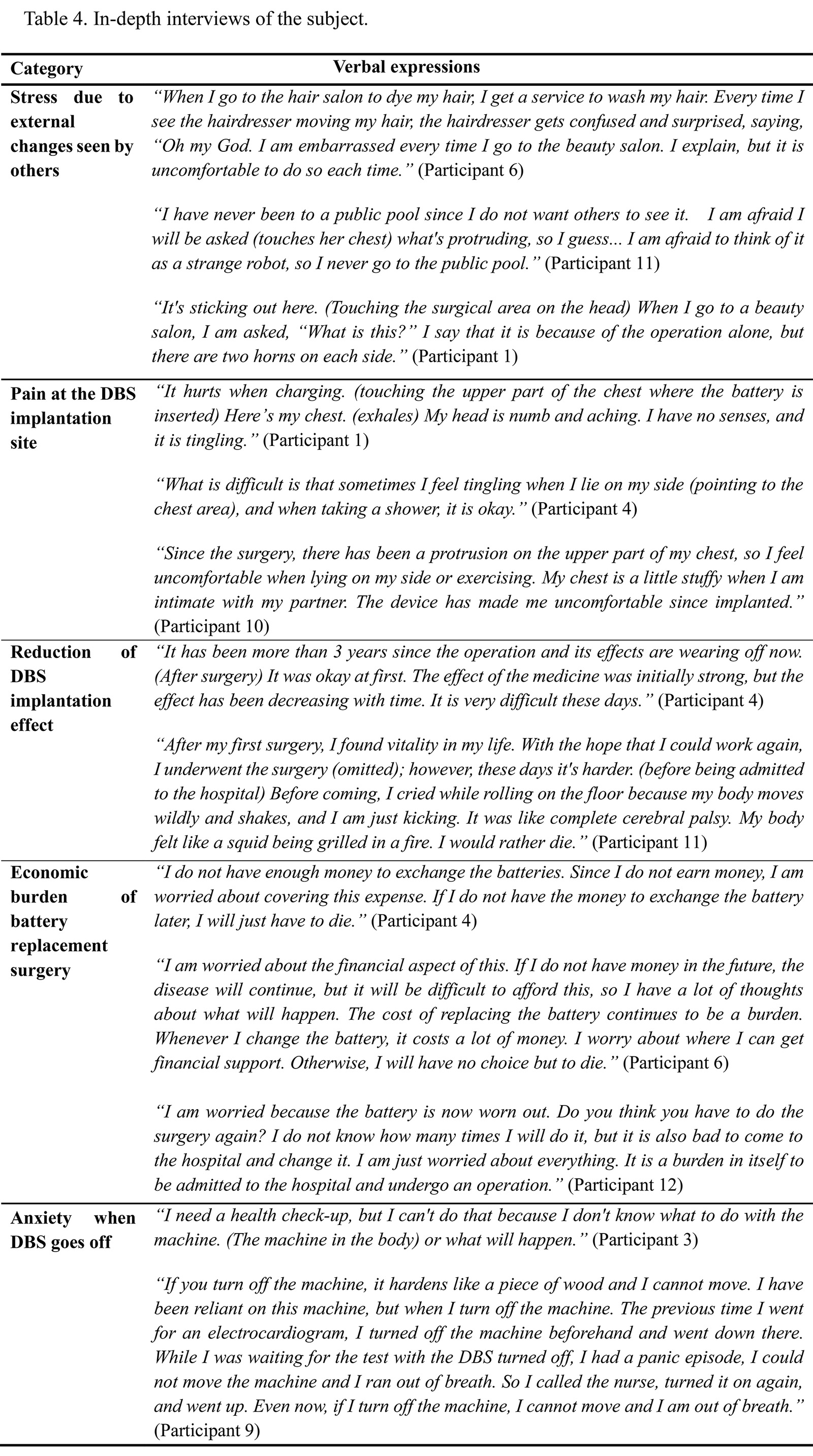Objective: This study aimed to investigate the changes in quality of life (QoL), depression and experiences of women with PD implanted with a DBS.This study aimed to investigate the changes in quality of life (QoL), depression and experiences of women with PD implanted with a DBS.
Background: Despite a rise in deep brain stimulator (DBS) implantation in women with Parkinson’s disease (PD) in Korea, these women’s experiences and changes in QoL remain unclear.
Method: This mixed method case study analyzed and categorized the completed interviews of participants. Data were collected through questionnaires, individual in-depth interviews, and an electronic medical recording review. We recruited the patients from December 2019 to April 2020 to obtain qualitative data. We analyzed the United Parkinson’s Disease Rating Scale (UPDRS), Beck Depression Inventory (BDI), and the 39 item Parkinson’s disease questionnaire (PDQ-39) as quantitative data before and after DBS implantation.
Results: Twelve women with PD who underwent DBS implantation participated in this study. The average age was 57.5±8.8 years with an average implantation period of DBS of 5.9±5.0 years. The patient’s baseline UPDRS part III significantly improved after the surgery (39.3±10.4 vs 25.0±16.8; p=0.038). The axial symptoms (p=.003) and off duration (p=.008), and Mean Modified Hoehn and Yahr stage (p=.017) improved after DBS implantation and were statistically significant. However, BDI (20.3±11.5 vs 17.1±7.7) and PDQ-39 scores (60.3±24.2 vs 56.9±22.7) before and after surgery were not significantly different (0.45<P<0.70). The reasons for subjective dissatisfaction included “stress due to external changes seen by others,” “pain at the implantation site,” “reduction in DBS implantation effect,” “economic burden of battery replacement surgery,” and “anxiety when DBS goes off.”
Conclusion: Despite the improvement in motor symptoms in female patients with PD who underwent DBS surgery, the patient’s self-reported QoL and depression did not differ significantly before and after surgery. Medical service providers should assist patients, try to understand their discomfort and concerns, and handle them accordingly from a therapeutic point of view.
References: 1. Han S, Kim S, Kim H, Shin HW, Na KS, Suh HS. Prevalence and incidence of Parkinson’s disease and drug-induced parkinsonism in Korea. BMC Public Health 2019;19:1328.
2. Chan AK, McGovern RA, Brown LT, et al. Disparities in access to deep brain stimulation surgery for Parkinson disease: interaction between African American race and Medicaid use. JAMA Neurol 2014;71:291-299.
3. Pringsheim T, Jette N, Frolkis A, Steeves TD. The prevalence of Parkinson’s disease: a systematic review and meta-analysis. Mov Disord 2014;29:1583-1590.
4. Lee JE, Choi JK, Lim HS, et al. The prevalence and incidence of Parkinson′s disease in South Korea: a 10-year nationwide population–based study. Journal of the Korean Neurological Association 2017;35:191-198. Korean.
5. Aum DJ, Tierney TS. Deep brain stimulation: foundations and future trends. Front Biosci (Landmark Ed) 2018;23:162-182.
6. Pusswald G, Wiesbauer P, Pirker W, Novak K, Foki T, Lehrner J. Depression, quality of life, activities of daily living, and subjective memory after deep brain stimulation in Parkinson disease—a reliable change index analysis. Int J Geriatr Psychiatry 2019;34:1698-1705.
7. Sugiyama K, Nozaki T, Asakawa T, Koizumi S, Saitoh O, Namba H. The present indication and future of deep brain stimulation. Neurol Med Chir (Tokyo) 2015;55:416-421.
8. Kleiner-Fisman G, Stern MB, Fisman DN. Health-related quality of life in Parkinson disease: correlation between Health Utilities Index III and Unified Parkinson’s Disease Rating Scale (UPDRS) in U.S. male veterans. Health Qual Life Outcomes 2010;8:91.
9. Dietrich AD, Koeppen JA, Buhmann C, et al. Sex disparities in the self-evaluation of subthalamic deep brain stimulation effects on mood and personality in Parkinson’s disease patients. Front Neurol 2020;11:776.
10. Jaspers L, Daan NM, van Dijk GM, et al. Health in middle-aged and elderly women: a conceptual framework for healthy menopause. Maturitas 2015;81:93-98.
11. Fetters MD, Curry LA, Creswell JW. Achieving integration in mixed methods designs-principles and practices. Health Serv Res 2013;48:2134-2156.
12. Pluye P, Hong QN. Combining the power of stories and the power of numbers: mixed methods research and mixed studies reviews. Annu Rev Public Health 2014;35:29-45.
13. Peto V, Jenkinson C, Fitzpatrick R. PDQ-39: a review of the development, validation and application of a Parkinson’s disease quality of life questionnaire and its associated measures. J Neurol 1998;245:S10-S14.
14. Steer R, Beck A, Garrison B. Applications of the beck depression inventory. In: Sartorius N, Ban TA, Eds. Assessment of depression. Berlin, Heidelberg, Springer, 1986; p123-142.
15. Lee EH, Lee SJ, Hwang ST, Hong SH, Kim JH. Reliability and validity of the Beck Depression Inventory-II among Korean adolescents. Psychiatry Investig 2017;14:30-36.
16. Park K, Jaekal E, Yoon S, Lee SH, Choi KH. Diagnostic utility and psychometric properties of the Beck Depression Inventory-II among Korean adults. Front Psychol 2019;10:2934.
17. Tong A, Sainsbury P, Craig J. Consolidated criteria for reporting qualitative research (COREQ): a 32-item checklist for interviews and focus groups. Int J Qual Health Care 2007;19:349-357.
18. Yin RK. Case study research and applications. 6th edition. Thousand Oaks, CA, Sage, 2018, pp 319.
19. Chiou SM. Sex-related prognostic predictors for Parkinson disease undergoing subthalamic stimulation. World Neurosurg 2015;84:906-912.
20. Mathers J, Rick C, Jenkinson C, et al. Patients’ experiences of deep brain stimulation for Parkinson’s disease: a qualitative systematic review and synthesis. BMJ Open 2016;6:e011525.
21. Baertschi M, Favez N, Radomska M, et al. An empirical study on the application of the burden of normality to patients undergoing deep brain stimulation for Parkinson’s disease. Journal of Psychosocial Rehabilitation and Mental Health 2019;6:175-186.
22. Palacios-Ceña D, Losa-Iglesias ME, Alvarez-López C, et al. Patients, intimate partners and family experiences of implantable cardioverter defibrillators: qualitative systematic review. J Adv Nurs 2011;67:2537-2550.
23. Gilbert F, Goddard E, Viaña JNM, Carter A, Horne M. I miss being me: phenomenological effects of deep brain stimulation. AJOB Neuroscience 2017;8:96-109.
24. Hariz GM, Limousin P, Tisch S, Jahanshahi M, Fjellman-Wiklund A. Patients’ perceptions of life shift after deep brain stimulation for primary dystonia—a qualitative study. Mov Disord 2011;26:2101-2106.
25. de Haan S, Rietveld E, Stokhof M, Denys D. The phenomenology of deep brain stimulation-induced changes in OCD: an enactive affordance-based model. Front Hum Neurosci 2013;7:653.
26. de Haan S, Rietveld E, Stokhof M, Denys D. Effects of deep brain stimulation on the lived experience of obsessive-compulsive disorder patients: in-depth interviews with 18 patients. PLoS One 2015;10:e0135524.
27. Schüpbach M, Gargiulo M, Welter ML, et al. Neurosurgery in Parkinson disease: a distressed mind in a repaired body? Neurology 2006;66:1811-1816.
28. Stroop R, Holms F, Nakamura M, Lehrke R. A submammarian approach for cosmetically improved implantation of deep brain stimulation generators. World Neurosurg 2018;109:e699-e706.
29. Fenoy AJ, Simpson RK, Jr. Risks of common complications in deep brain stimulation surgery: management and avoidance. J Neurosurg 2014;120:132-139.
30. Beery TA, Sommers MS, Hall J. Focused life stories of women with cardiac pacemakers. West J Nurs Res 2002;24:7-27.
To cite this abstract in AMA style:
MS. Kim, S. Jo, KW. Park, SH. Lee, YS. Hwang, SJ. Chung. Change in quality of Life, depression, and lived experiences of women with Parkinson’s disease after deep drain stimulation [abstract]. Mov Disord. 2023; 38 (suppl 1). https://www.mdsabstracts.org/abstract/change-in-quality-of-life-depression-and-lived-experiences-of-women-with-parkinsons-disease-after-deep-drain-stimulation/. Accessed December 29, 2025.« Back to 2023 International Congress
MDS Abstracts - https://www.mdsabstracts.org/abstract/change-in-quality-of-life-depression-and-lived-experiences-of-women-with-parkinsons-disease-after-deep-drain-stimulation/

